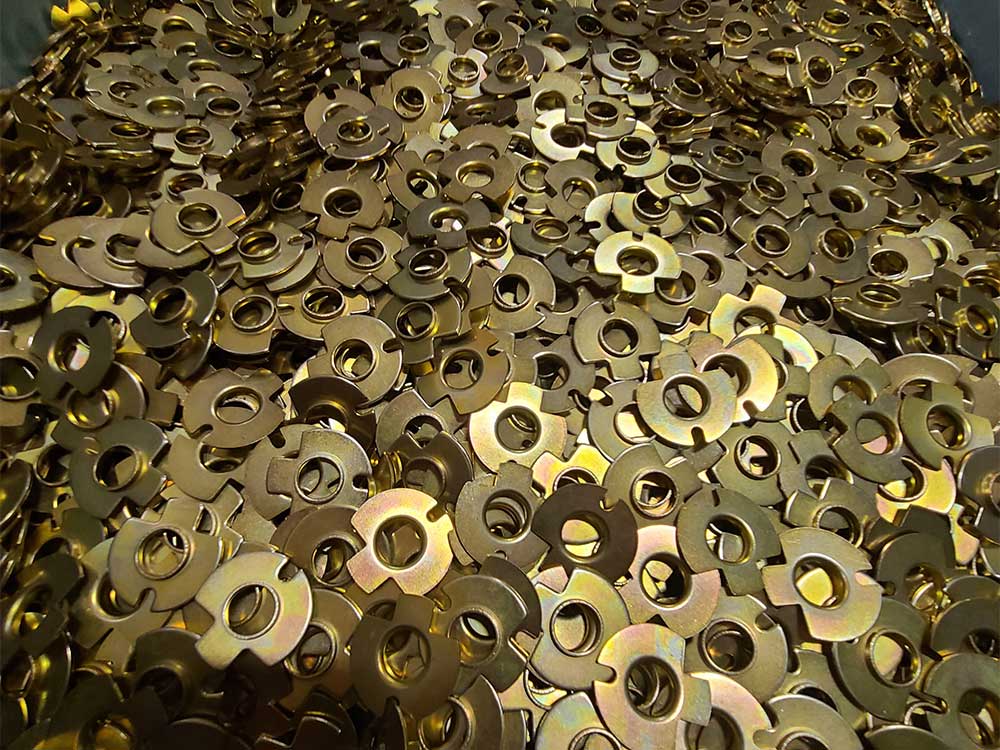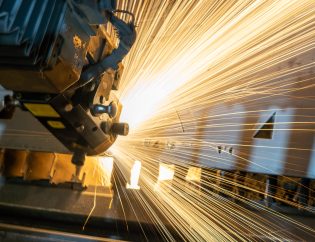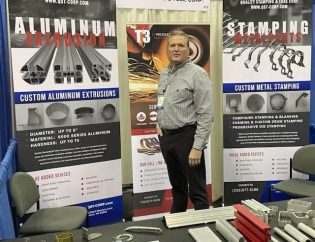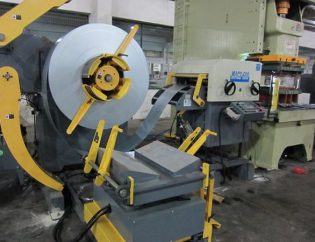
Metal stamping is a cold metal working process that involves the use of dies and stamping presses to shape, form, and manufacture complex parts and components. The various metal-stamping processes include blanking, bending, punching, and piercing that produce distinct shapes and configurations. Metal stamping is a fast and cost-effective method for producing large quantities of parts with excellent tolerances.
The materials used for metal stamping are sheets of various metals, which vary in accordance with the type of part to be produced. Sheets of stainless steel, carbon steel, galvanized steel, copper, brass, and aluminum are the most common metals used by the metal-stamping process.
Metal Stamping Process
Metal stamping, in its most basic form, is pressing a flat sheet of metal into various shapes using a stamping press and stamping die. The die produces the desired shape of the piece to be pressed.
Metal Stamping Pressing
There are several different types of stamping presses, all of which have the same function. The press has a ram that applies downward force against the sheet of metal that rests on the bed of the press.
Forces in Stamping
Presses take several shapes and forms and depend on some type of power to provide stamping force. Mechanical presses exert force using a flywheel, single gear design, double gear design, or some form of eccentric gear design. Hydraulic presses are powered by a hydraulic pump and hydraulic cylinder that drive the ram downward.
Stamping Dies
Stamping dies shape a metal sheet using a punch that pushes the metal sheet through the die. Punches can be single or multistage depending on the requirements of the final part. With single-stage (or single-stroke) stamping presses, one stroke of the ram produces the desired shape. Multistage stamping presses shape a metal sheet with progressive stamping.
Finishing Options for Metal Stamping
Parts produced using metal stamping are subjected to secondary processes designed to plate, clean, heat treat, or deburr the finished piece. There are several different value added services based on one’s metal-stamping part requirements.
Types of Metal Stamping
Metal stamping is a generic term that refers to several types of metal forming and shaping processes. The choice of metal-stamping method is dependent on the design of the part, the type of metal used, and the number of parts to be produced. A CAD rendering from an engineer defines the process and the type of die to be used.
Progressive Die Stamping
Progressive die stamping includes bending, punching, coining, and several other techniques used to change and transform raw metal. This process incorporates an automatic feeding system that pushes a metal strip into a progressive stamping press. Each stage has a different die that performs a different modification.
There are many factors to be considered when designing a progressive die (progressive die set). Part orientation, how parts are carried in the strip, the order of the operations, and how parts are ejected from the machine are just some of the elements engineers weigh when creating a progressive die. The key to any successful project begins with the information provided to designers and engineers by the customer during the design phase.
During the progressive stamping process, a servo press-feed technology feeding system is used to move a strip of metal through the multiple stations of progressive stamping dies. The number of dies varies according to the geometry and complexity of the desired part. The final station is a cutoff operation that separates the finished part from the carrying web. The web and punched-away metals are treated as scrap as they are knocked down and ejected from the die set.
Short-Run Stamping
Short-run stamping is an inexpensive method for producing prototypes with orders, ranging from a few parts or several thousand, requiring a short lead time. A mixture of pre-made and custom tools are placed at a one-hit station with multiple steps for producing complex parts. Products produced by short-run stamping are strong and durable using metal sheets with thicknesses up to 1/4 of an inch.
For customers, short-run stamping is a flexible process designed to fit their specific requirements of geometric shapes at the quantities they desire. Some of the major benefits of short-run stamping include reduced setup times and quick, on-time delivery.
Compound Die Stamping
Compound die stamping is used for low, to medium, volume orders of stamped parts using less expensive dies. This process is used for flat blanks, drawn cups, and rings with tight tolerances. The benefit of compound die stamping is the lower tooling costs required for producing the compound die.
Compound dies perform more than one cut in a single press. They cut internal and external aspects of a part with a single stroke, producing the finished part at one station. This process eliminates the need to move a part through multiple stations and increases mechanical accuracy.
Applications for Metal Stamping Parts
Metal stamping is a critical industrial operation for the production of viable and durable parts. The metal stamping process is used to produce a wide range of components for the automotive and aerospace industries. Medical equipment manufacturers depend on metal stamping to create the precision parts that must meet their industry's stringent requirements. This same principle is true for parts produced for telecommunications and electronics manufacturing.
The types of parts produced by metal stamping include simple washers, springs, and brackets, as well as more complex and intricate parts such as engine bases and friction plates. Large machinery designed to manufacture components that meet industrial standards depend on metal-stamped parts as part of their structure. This is also true of tiny components used to build micro equipment that are produced by precision micro stamping.
Whether serving as just a tiny detail or a large, essential component of a finished design, engineers and designers consider metal-stamped parts as fundamental elements. This wide use of metal stamping is due to the many metals that one is able to precision shape with very high tolerances. Metal-stamped parts can be found in your kitchen stove and on overhead hoists that lift tons of material.
Have questions about your application? Our experts are here to help! Contact Us.
OEM Stamping
OEM stamping, or original equipment manufacturing stamping, is the production of stamped metal parts requiring the precision and repetitive accuracy needed to meet OEM product design standards. The key to OEM stamping is the production of parts with exceptionally tight dimensional tolerances, which is a necessity for OEM parts.
The stamping of OEM parts takes several configurations, which include low to high volume orders using progressive stamping and fabrication. With OEM stamping, it is essential to be able to work with a wide range of metals including stainless steel, carbon steel, brass, and aluminum, all of which are used in OEM part design.
An important part of OEM stamping is the ability to be flexible and adaptable in order to meet part designs and requirements. Exceptional part tolerances within ± 0.0010”, high precision, accuracy, and on-time delivery are the results of successful OEM stamping.
Metal Stamping Operations
Metal stamping is a high-volume, cold-working, metal-shaping process that produces identical parts with high tolerances. Metal stamping is designed for short and long production runs using one, or a series of, metal-shaping operations required to produce accurate and precision components.
Metal stamping operations include:
- Punching – removes a scrap piece of metal by punching a metal sheet against a die.
- Blanking – removes the required part from a metal sheet.
- Embossing – is the process of creating a raised or recessed design on a metal sheet.
- Coining – is a bending process where a metal sheet is positioned between the die and punch. This process causes the tip of the punch to pierce the metal for an accurate bend.
- Bending – forms a metal sheet into various shapes including L, U, and V profiles. It is a plastic deformation process.
These procedures are just a small sampling of the many metal-stamping processes that are used to meet the requirements of the countless parts and components produced through metal stamping. Metal stamping is essential for the development and production of parts for machinery and equipment. It is an ancient process that has been modernized with CNC machines and CAD designs.
The Quality Stamping & Tube Difference
For over forty years, our staff at Quality Stamping and Tube Corporation has been delivering high-quality, high-tolerance, precision parts with the guarantee that they will meet and exceed customer standards. Our goal at QST is to put our many years of experience and know-how into every project we tackle, regardless of its size and requirements. As an ISO 9001:2015 certified company, we live up to the vision of excellence our customers expect. Contact us or 262-677-5100. We are ready to serve you.
Ready to get your project started?
Contact QST today for a free quote!






